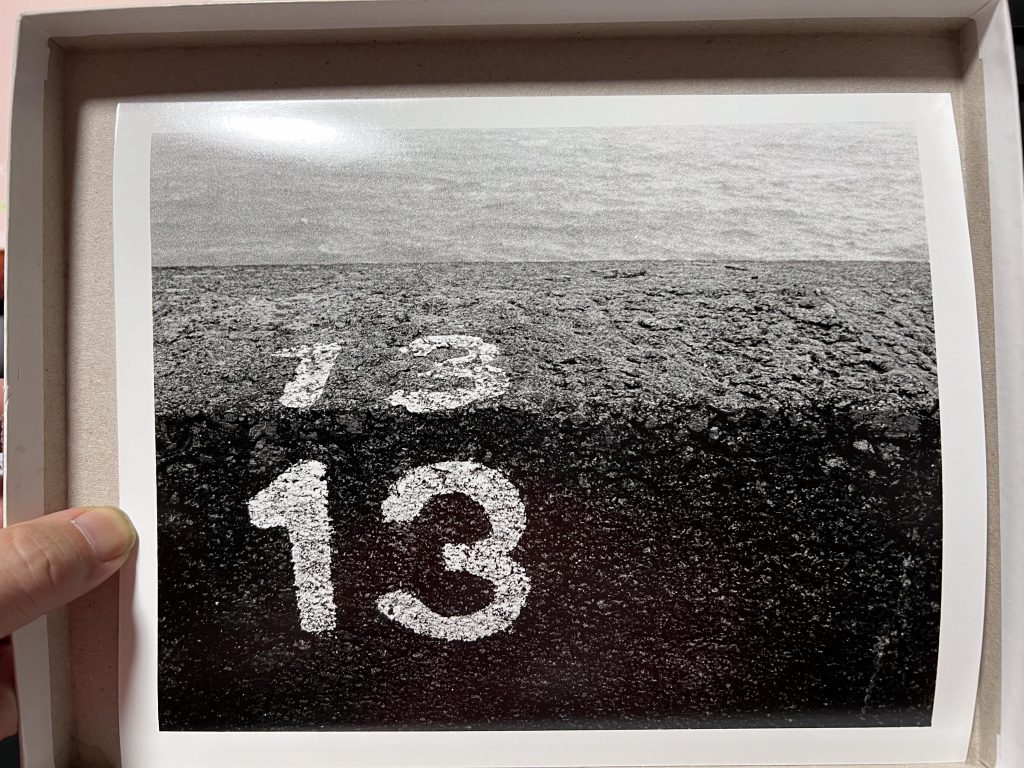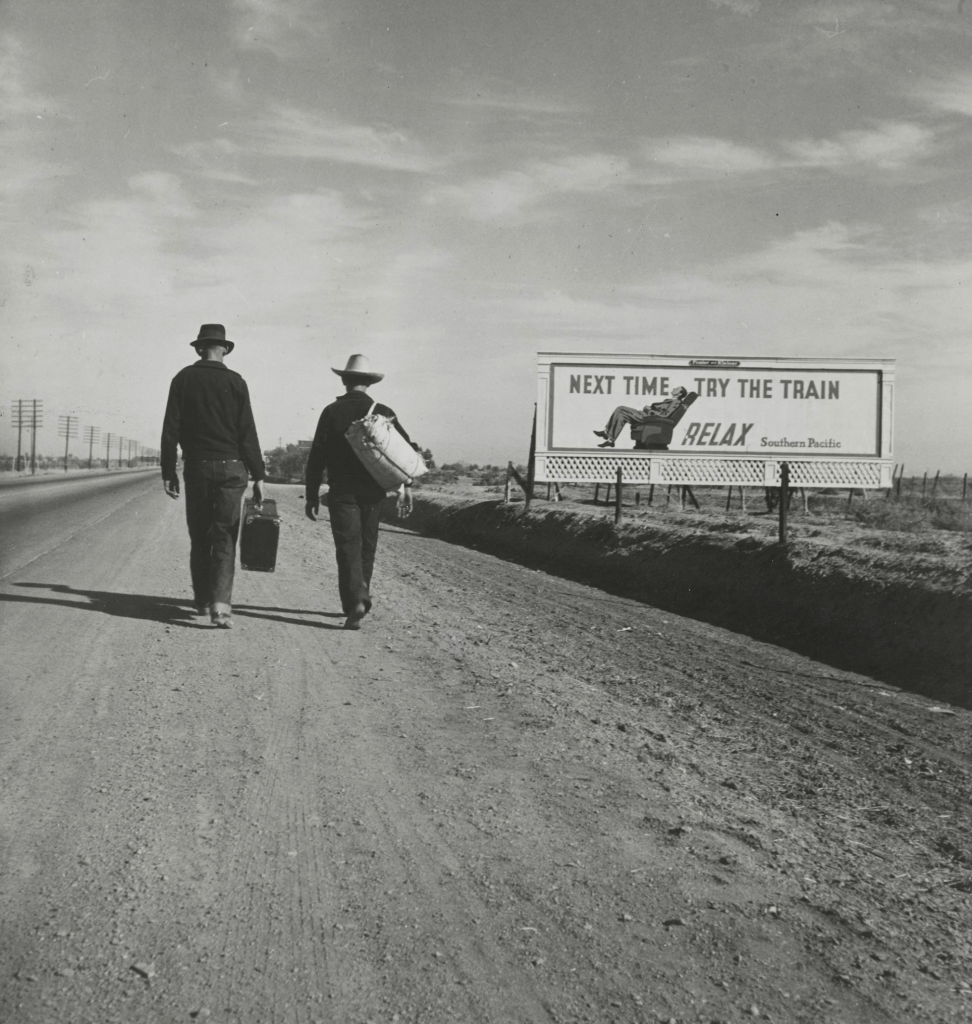Tuesday morning and I’d taken with me some colour paper so I could create some contact sheets from three colour films I’ve got ready. When I got there the media stores were closed so I jsut went and got on with reading some books an chatting to coursemates about the work they’re doing at the moment.
Practice Tutorial
Later in the morning I went to room MX204 for our Practice Tutorial with Sylvia. Practice refers to our practice as photographers and artists and how we are progressing researching and producing work ahead of the exhibition at Easter next year.
I showed Sylvia some of my recent photos I’d made in Margate and Southend at the weekend and discussed the photos I’m taking and the possible reasons behind it. I mentioned that I like empty spaces or spaces with anonymous people in them, then I spoke about my understanding of liminal spaces being places that people or things go through to get somewhere else. I like taking photos of the concrete buildings and car parks as nobody hangs around them for fun and they’re on their way somewhere else.

Sylvia said that I need to have a thread to focus on and then follow along it and see where it takes me, if I pick up a thread about liminal spaces and then have that in mind when I’m shooting then the photos will mean that to me and will provide a theme for the exhibition contents. I showed her a picture from last week’s B&W printing session and she said she liked it. It does fit into my Liminal spaces thread as it’s on the breakwater at Holyhead, Anglesey. Not somewhere people go to spend long periods of time. It’s merely a tool to prevent the wind, waves and tides having a larger impact on the harbour there. It was also 1.7miles long so not somewhere you go to sit down, more of a place where people will use for a running goal or a nice stroll at the weekend.

I also mentioned that I still plan on going to Tokyo in January and when was the first week of teaching back again. She told me that we’re back in week commencing January 22nd so I knew when to go and book the flights etc. I’m hoping that some photos I make in Tokyo, or on the way there and back might fit into the Liminal Space theme. After all airports, train stations, metro stations, bus stations, and streets and roads are all places a person goes via to get somewhere else.
I discussed about goal setting and if I set a goal to follow a liminal space path, then my Reticular Activating System will help me find photographs or adventures that lead me to a photograph. I mentioned that this is the same process that happens when you buy a new car and suddenly see lots of the same model that you wouldn’t have noticed before. I picked up on this during a course with the Pacific Institute and Lou Tice in the early 2000s. and setting goals or affirmations will open your eyes to see opportunities you may not have seen previously.
For lunch time, when I was planning on doing some colour printing, I went around town for a walk with the camera. This time I walked around the brewery area and through the bottom end of the city centre before ending up back at the university for the afternoon session in the lecture theatre.
Contextual session
Sylvia opened up the session saying that we will be using these lecture times to look at some subjects and have varied discussions and debates on various topics. We will be looking at work that will go through from level 5 and then into level 6 for the degree show and dissertation.
Taking in the classroom rather than more formal stuff, discussing ideas, books, videos. Sylvia asked if any of us had watched any videos about photography.
Emma mentions Trevor Wisecup being interviewed and how he includes ethics in his street photography practice. This sounded like a video by Paulie B on a Walkie Talkie to me,
I then mentioned the video I’d watched by Paulie B featuring Ribsy the street photographer and how he deals with the subjects of his photos and why he takes some pictures and doesn’t capture others.
Shellie mentioned an audiobook on YouTube by Marcel Proust, “In search of lost time” in which the author recalls times gone by from childhood all the way through to the time of his death. It’s known for bein gone of the longest books ever.
Sylvia then told us how Gavin had recommended a video;
“If only for a second” by Mimi foundation on YouTube, it featured cancer patients who feel no lnger carefree. They were treated to a makeover with a wig and full face of make up, whilst keeping their eyes closed. They were then sat in front of a two way mirror with a photographer capturing the moment they open their eyes to see their new temporary look. It was a single moment of feeling carefree. It was a lovely story, and I think the participants got something from the endeavour too, but I didn’t feel 100% comfortable with it for some unknown reason.

Sylvia then shared a video of the Words and Pictures exhibition at MoMA by Dorothea Lange. We had a discussion afterwards about how the subjects of Lange’s images were not empowered by the photos at the time, and that they were simply images of the events of the day. Sylvia told us that Lange didn’t consider it as art but this takes us back to our discussions on Post Documentary, Post Photography by Martha Rosler, in that images made of everyday events in the past become an item of art in the future, or increased importance due to the passing of time.

Post Documentary, Post Photography Discussion
Next was a chat about the Martha Rosler text and after we’d discussed that it was difficult to read in one go, Sylvia asked if there were words in the text that we had trouble with. Beth chose the word “dichotomies” as a troublesome piece. We discussed how the words like this are a good tool to explain the battle between two schools of thought with fewer words, hence keeping word counts down and using more succinct language.
I mentioned that I struggled with the “Post documentary” term and had to do some reading up on it. Eventually figuring out that it meant that the original form of documentary produced have changed to include different methods of telling stories. Some post documentary work is left ambiguous purposefully to stimulate thought process in the viewer/reader. This replaces the older view that documentary photography needed a commentary or quotes from the subjects involved.
Emma chose a word that I cannot remember for the life of me, if it comes back to me I’ll edit this section.
Noah chose the words epistemological, ephemeral and metonymic. I too had to look these words up when I was reading the text but I felt, as Noah did too that the text flowed and the meaning of the words was somehow conveyed by the whole sentence or passage.
We talked about how academic language can seem elitist and inaccessible, with Sylvia explaining that she does not use the academic variety of phrases in everyday life as she grew up on a council estate in London. It was discussed that one doesn’t need to use academic wording to sound more serious or be taken more seriously but there is a benefit in using it to making writing take up fewer words and explain concepts without a huge explanation. Bell Hooks did some work on taking apart academic language to explain to layperson and in her book Teaching to Transgress (1994) she discusses how breaking apart language can open up writing and reading to all classes.
Artists Library Task Discussion
For a contextual essay we have to write 1000 words on a text whether it’s a book, poem, song or anything else, and how it inspires our practice. We were asked to discuss what we’d chosen to write about and this list is the result.
- Ieva has selected a book on the history of Lithuania, her home country, it’s heritage and why the land is how it is. She told us all that she wants to explore her background and will need to translate some of it, as it is in Lithuanian.
- Emma has chosen Eckhardt Tolle’s book “The power of now” and how it’s central message of living life for the present moment has helped her in the past to get through some difficult times.
- Shellie has gone musical on us and chosen a song, Moon River from the film Breakfast at Tiffany’s and will discuss how this has influenced her practice.
- Due to learning about Asperger’s and its effects, along with recommendations from his father Noah chose the book “The reason I jump” by Naoki Higashida, He told us he was going to write about “The Curious Incident Of The Dog in The Night-Time” by Mark Haddon but went with the former due to the way it’s written being more interesting.
- Cody has narrowed it down to two, The Woman Who Lied by Claire Douglas or IT by Stephen King. Sylvia said that IT is an incredibly long book so Codey could select a section or couple of chapters to write about if the whole book was. a bit much.
- Beth selected Ned Vizzini’s book “It’s Kind Of A Funny Story” for personal reasons she explained and it sounds like a good read and inspirational text. I’ll be interested to see how this book manifests itself in her work.
- Obviously, I explained a little about how I’d selected “The Dark Knight Returns” by Miller, Klaus and Janson. It’s a graphic novel and the images in the book triggered some inner artist in me back in 1988 when I started getting interested in painting and art eventually winding up being a photographer.
What’s Next
Next Tuesday 10:30 we have a group practice review. Talk for five minutes on images and motives behind the practice we’re taking part in. For me it’ll be a discussion about deserted, empty and liminal spaces along with some of my influences.
Next Tuesday afternoon sees us receive a seminar on “Art writing and exhibition making”
For Week 7 will look at the Eagle Works space above the Mander Centre to see if it’s suitable for the exhibition we’ll be displaying in Easter ’24. Sylvia said she already had a theme across all of our works that would tie up the whole show, so I’m interested in knowing what she has seen that is common across all seven of our practices.
Sylvia has also offered to read some drafts if required of Artists Library task, so she can advise of any improvements we could make, ahead of the formative submission in December.
Be First to Comment